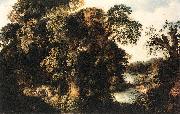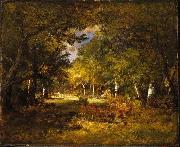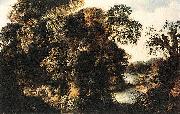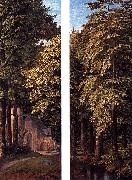Wholesale Oil Painting No Minimum |
|||||||||||
|
|
|||||||||||

|
|||||||||||
|
|
|
||||||||
KEIRINCKX, AlexanderFlemish painter (b. 1600, Antwerpen, d. 1652, Amsterdam). Flemish painter. He was the son of Matthijs Keirinckx and Anna Masson. In 1619 he became a master in Antwerp's Guild of St Luke, he married Clara Matthausen on 18 June 1622, and in 1624 he took on Artus Verhoeven as an apprentice. From 1636 onwards he is regularly recorded in Amsterdam, where he was registered as a citizen in the year of his death. He visited Great Britain, possibly in 1625 (Walpole mentions two signed and dated drawings of London views from this year) and definitely in 1640-41, when he undertook commissions from King Charles I to paint views of royal castles and palaces. |
||||||||
|
|
||||||||
Forest Scene
Forest Scene Painting ID:: 7722 |
Oil on oak, 56,5 x 87,5 cm
National Gallery, Prague
Oil on oak, 56,5 x 87,5 cm National Gallery, Prague |
|||||||
|
|
||||||||
Brooklyn1866--1925 |
||||||||
|
|
||||||||
|
|
Forest Scene
Forest Scene Painting ID:: 68949 |
Medium oil on cradled panel
Dimensions 44.9 X 54.9 cm
Medium oil on cradled panel Dimensions 44.9 X 54.9 cm |
||||||
|
|
||||||||
Alexander KeirincxAlexander Keirincx (Antwerp, 23 January 1600-Amsterdam, 1652) was a Flemish Baroque painter who spent his later career in the Dutch Republic. He became a master in Antwerp's guild of St. Luke in 1619, and like his teacher Abraham Govaerts he initially specialized in small cabinet-sized forest landscapes in the manner of Jan Brueghel the Elder and Gillis van Coninxloo. Also like Govaerts, Keirincx's early works typically show diminutive history, mythological or biblical subjects within a Mannerist three-color universal landscape bracketed by repoussoir trees. However, during the 1620s his landscapes become increasingly natural. He lived in Utrecht and Amsterdam from 1628 until the end of his career, and made trips to England to decorate palaces for Charles I. The figures in his works were usually painted by collaborators such as Cornelis Poelenburg.[1] Keirincx worked primarily as an art dealer later in life. |
||||||||
|
|
||||||||
|
|
Forest Scene
Forest Scene Painting ID:: 90405 |
first half of 17th century
Medium oil on oak
Dimensions Height: 56.5 cm (22.2 in). Width: 87.5 cm (34.4 in).
cyf first half of 17th century Medium oil on oak Dimensions Height: 56.5 cm (22.2 in). Width: 87.5 cm (34.4 in). cyf |
||||||
|
|
||||||||
Gerard Davidb.c. 1460, Oudewater, Neth. d.Aug. 13, 1523, Bruges Flemish Gerard David Locations Netherlandish painter. He is known as the last of the Flemish Primitives. Although born in the northern Netherlands, he moved to Bruges as a young man, and most of his work expresses the impassive, unmannered, microscopically realistic approach peculiar to south Netherlandish art in the time of Jan van Eyck. David was skilled at synthesizing the art of several important south Netherlandish predecessors, adapting, for instance, the compositions of van Eyck and the technique of Hugo van der Goes. He was also influenced by Hans Memling, whose example led him to refine and polish his cruder northern Netherlandish style and to adopt the popular theme of the Virgin and Child enthroned. |
||||||||
|
|
||||||||
|
|
Forest scene
Forest scene Painting ID:: 92822 |
c. 1505-1515
Medium oil on oak panel
Dimensions Height: 89.9 cm (35.4 in). Width: 30.7 cm (12.1 in).
cjr c. 1505-1515 Medium oil on oak panel Dimensions Height: 89.9 cm (35.4 in). Width: 30.7 cm (12.1 in). cjr |
||||||
|
|
||||||||
|
Gerard David b.c. 1460, Oudewater, Neth. d.Aug. 13, 1523, Bruges Flemish Gerard David Locations Netherlandish painter. He is known as the last of the Flemish Primitives. Although born in the northern Netherlands, he moved to Bruges as a young man, and most of his work expresses the impassive, unmannered, microscopically realistic approach peculiar to south Netherlandish art in the time of Jan van Eyck. David was skilled at synthesizing the art of several important south Netherlandish predecessors, adapting, for instance, the compositions of van Eyck and the technique of Hugo van der Goes. He was also influenced by Hans Memling, whose example led him to refine and polish his cruder northern Netherlandish style and to adopt the popular theme of the Virgin and Child enthroned. Forest scene c. 1505-1515 Medium oil on oak panel Dimensions Height: 89.9 cm (35.4 in). Width: 30.7 cm (12.1 in). cjr |
||||||||
|
|
||||||||
|
Prev Next
|
||||||||
|
|
||||||||
|
Related Paintings to Gerard David :. |
||||||||
|
|
||||||||
|
CONTACT US |




